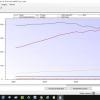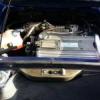
Boost Pressure On Supercharged Cars
#21

Posted 10 July 2016 - 09:36 PM
#22

Posted 10 July 2016 - 09:48 PM
#23

Posted 10 July 2016 - 10:20 PM
if you have the same tension both a 5pk and 6pk then the extra 20% surface area will aid grip and will reduce any slip.
i know what your saying about the same pressure on a smaller surface area will "dig in" more, but serpentine belts are designed to mesh together, also think about why we use wider tyres. if we applied your theory then we would all be driving around 100/45/75 wheels/tyres.
#24

Posted 11 July 2016 - 06:27 AM
The real boostpressure is a lot more complex with sc leak paths and thermal efficiency etc., but you get the point.
Yup..
Also on a fixed displacement charger you can often see a change in the manifold over-pressure when the engine comes 'on cam' and the volumetric efficiency of the engine reaches it's peak capacity.
In that case on a dyno you'd see the 'boost' pressure drop, but the power output actually going up as the engine is 'consuming' more of the air that's pushed into the manifold and making bigger 'bangs' with it.
Where this point in the RPM range is, depends on the cam profiles and timing, but usually before and after this the manifold pressures will be higher as the engine is working further away from it's optimal VE point.
Would be interesting if anyone ever fits a twin-screw/Lysholm charger (eg. Whipple, Mecedes) on these engines as they have very little to no leak-back and are actually compressing the air as part of their transport while still being a fixed-displacement so they tend to keep on pushing air hard even at high rpm's.
Of course to combat belt slip one (extensive) option would be to change all the pulleys to toothed types and use a toothed belt ![]()
Bye, Arno.
#25

Posted 11 July 2016 - 08:16 AM
#26

Posted 11 July 2016 - 08:42 AM
#27

Posted 11 July 2016 - 09:24 AM
The real boostpressure is a lot more complex with sc leak paths and thermal efficiency etc., but you get the point.
Yup..
Also on a fixed displacement charger you can often see a change in the manifold over-pressure when the engine comes 'on cam' and the volumetric efficiency of the engine reaches it's peak capacity.
In that case on a dyno you'd see the 'boost' pressure drop, but the power output actually going up as the engine is 'consuming' more of the air that's pushed into the manifold and making bigger 'bangs' with it.
Where this point in the RPM range is, depends on the cam profiles and timing, but usually before and after this the manifold pressures will be higher as the engine is working further away from it's optimal VE point.
Would be interesting if anyone ever fits a twin-screw/Lysholm charger (eg. Whipple, Mecedes) on these engines as they have very little to no leak-back and are actually compressing the air as part of their transport while still being a fixed-displacement so they tend to keep on pushing air hard even at high rpm's.
Of course to combat belt slip one (extensive) option would be to change all the pulleys to toothed types and use a toothed belt
Bye, Arno.
![]()
Unless you have a silly error (like belt slip, boost leakage) then I'd also be inclined to think the same as above, i.e. relationship between V.E. and boost.
On a motorbike engine (designed for max power) manufacturers will likely make VE way up high in the rev range (circa 9000 to 11000 RPM).
On an basic Astra road car engine (designed for max fuel efficiency) then VE will likely be around 3000 RPM (for cruising down motorways).
On your engine, with (presumably) some head work mods then you might expect VE to move up to a couple of thousand RPM. This might be why the boost dies off at circa 5000 RPM. In theory it should rise again by about 6500, but I suspect (at a guess) that it doesn't due to restriction of the laminovas. A test for this would be to pull the laminovas out and see if you get improvement.
If non of these things is the issue, then I'd guess you'll need a bigger supercharger, seeing as you have higher CC and maybe an engine that can really gulp the air (i.e. overall high VE combined with higher CC). I had this on my engine and underestimated how far VE got pushed up the RPM band (which is a good thing mainly), my power curve doesn't flatten until 8000 RPM with the mid sized turbo it has; with a big turbo it would probably flatten at 9000 RPM.
GL, keep spannering, this is a nice and interesting step forward for the Z22. ![]()
Edited by Nev, 11 July 2016 - 09:48 AM.
#28

Posted 13 July 2016 - 08:17 PM
#29

Posted 13 July 2016 - 09:02 PM
I'm running an ls4 throttle body and also at the time there was no intake system fitted so it would have been taking all the air it wanted. Will do some more tests next time I'm on the rollers.....which won't be long now hopefullyCould this be an intake restriction issue? The charger can only compress the available air. Once the air pressure drops on the intake side of the charger, I believe that the boost drops by a multiple of the reduction in intake pressure?
#30

Posted 13 July 2016 - 10:34 PM
When you are on the rollers, can you puch it already from low rpm to see the low end torque of those cams? Interested to see the behavior of the cams there.
0 user(s) are reading this topic
0 members, 0 guests, 0 anonymous users




















